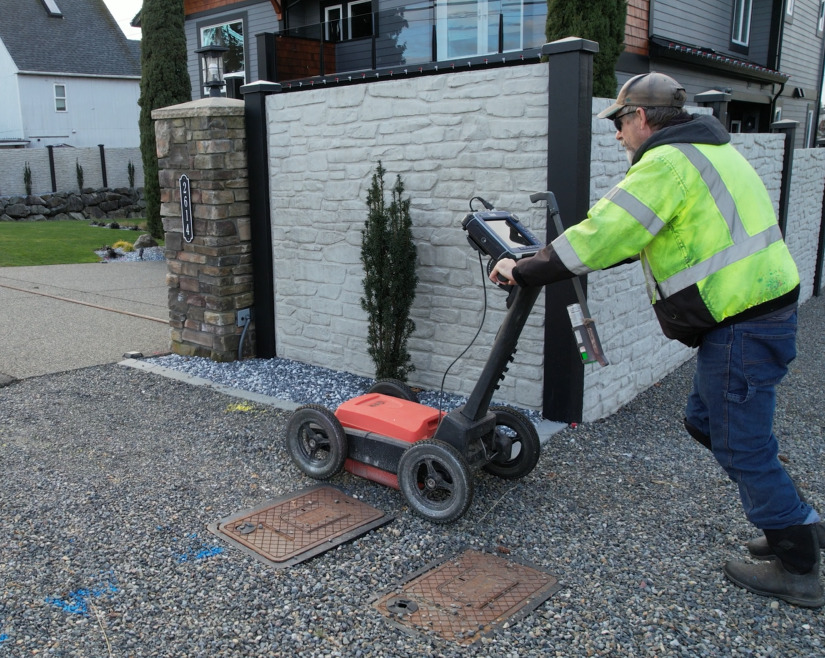Understanding How Ground Penetrating Radar Works

Ground Penetrating Radar (GPR) uses polarized high-frequency radio waves to penetrate the grounds surface. When the electromagnetic pulses enter the grounds surface, they produce reflections based on the conductive and dielectric properties of the objects within and in the surrounding materials.
The operation of GPR antennas used by CNI Locates can be summarized by the following:
- The antenna sends an electromagnetic pulse into the ground to record the strength and the time required for the return of any reflected signal.
- A series of pulses over a specific area make up what is referred to as a scan.
- The pulses sent into the subsurface are distorted or reflected back depending on the conductive and dielectric properties of the subsurface materials.
- Reflections are produced whenever the energy pulse enters a material with dissimilar electrical conduction properties or dielectric permittivity from the material it left.
Radar energy is emitted in a cone shape. The two-way travel time for energy at the leading edge of the cone is longer than for the energy directly beneath the antenna because that leading edge of the cone represents the hypotenuse of a right triangle.
Since it takes longer for that energy to be received, it is recorded farther down in the profile. As the antenna is moved over a specific target, the distance between the two decreases until the antenna is over the specific target and increases as the antenna is moved away. For this reason, a specific target will appear in the data as a hyperbola. The target is at the peak amplitude of the positive wavelet.
Limitations of GPR
What GPR is Used For
CNI Locates performs ground penetrating radar services in all of Oregon and Washington State for apartments & condominiums, archaeologists, builders, bridges, commercial companies, contractors, engineers, environmental companies, factories, high rise buildings, homeowners, medical buildings, military facilities, municipal buildings, new construction projects, ports, renovations, restaurants, retail stores, roads & highways, surveyors, warehouses, etc. whenever subsurface work is going to be conducted. CNI Locates utilizes nondestructive low frequency and high frequency ground penetrating radar antennas with a range of 250 MHz – 2600 MHz to perform ground penetrating radar services. These antennas are typically used to locate graves, underground storage tanks (UST’s), septic systems, conduits, utilities, rebar, post tension, metallic objects, non-metallic objects, voids, etc. in concrete and under the subsurface. Before you perform subsurface work, it is highly recommended to have that area scanned by our lower frequency ground penetrating radar (GPR) push carts for deeper visuals and with high frequency ground penetrating radar concrete scanning antennas for shallower applications, so you can protect the integrity of your work area by helping you avoid any important features or utilities while performing subsurface work.
Ground penetrating radar offers a non-invasive method of locating hidden objects, both metallic and nonmetallic. It works best when there is high contrast in the dielectric properties between the ground and the surveyed objects. For this reason, metallic objects make the ideal targets, such as rebar in the concrete or utilities in the soil. However, this does not limit the potential of GPR; it is still capable of detecting a wide variety of materials in the subsurface. Some of the common materials the GPR technology used by CNI Locates can detect is metals, plastics, concrete, air pockets, voids, etc.
Advantages of Ground Penetrating Radar
GPR offers several benefits over other locating methods, including accessibility, cost, and safety. CNI Locates GPR antennas don’t produce any harmful radiation or by-products, which makes GPR safe to use for technicians and individuals surrounding the work area.
GPR typically locates smaller areas faster and more efficiently than only performing an electromagnetic (EM) scan. Ground penetrating radar is more reliable because it has the ability to look for non-conductible, inaccessible, or unknown utilities it can get a visual on that we don’t have access to locate electromagnetically.
What Applications Is Ground Penetrating Radar Used For?
The most common applications for GPR are listed below:
- Locating Utilities
The most common use for GPR is locating underground utilities and pipes. This non-invasive technique allows our technicians to know the location of utilities underground before a client performs subsurface work.
- Concrete Imaging/Scanning
CNI Locates utilizes nondestructive high frequency ground penetrating radar antennas with a range of 1500 MHz – 2600 MHz to perform concrete imaging and scanning services. These antennas are typically used to locate rebar, post tension, conduits, metallic objects, non-metallic objects, voids, etc. in and under concrete. CNI Locates also performs concrete slab scanning, concrete imaging, condition assessments, and structural inspections
- Identifying Potentially Hazardous Wastes
Technicians at CNI Locates can detect the presence of any oil drums, UST’s, oil tanks, etc. which could be toxic if the contents leak into the ground.
- Detecting Voids
Our expert technicians have the ability to detect subsurface voids or air gaps.
- Identifying Marked/Unmarked Graves
Our certified technicians are trained to inspect for marked/unmarked graves.
- Forensic Investigations
Our technicians have experience with using ground penetrating radar for forensic studies (crime scenes), missing persons, and human remains.
- Looking for Unknown Objects
CNI Locates technicians have experience in looking for unknown objects such as buried gold, family treasures, metals, etc.
- Environmental Studies
GPR has the ability to scan for changes in soil conditions such as fill, ice thickness, tree roots, buried stumps, etc.
See What Is Under the Subsurface with Our GPR Services!
GPR remains one of the best methods for accurately identifying underground utilities and features. CNI Locates certified technicians have been using this technology for years and offering its services to a variety of clients. We have field offices in Eugene, OR; Portland, OR; Everett, WA; Renton, WA; Seattle, WA; and Tacoma, WA. CNI Locates has been Oregon and Washington States leader in subsurface utility detection and inspection services for 20+ years. Contact CNI Locates at (877) 826-1177 or email [email protected] to schedule a service within 24 hours’ notice, Monday-Friday.

